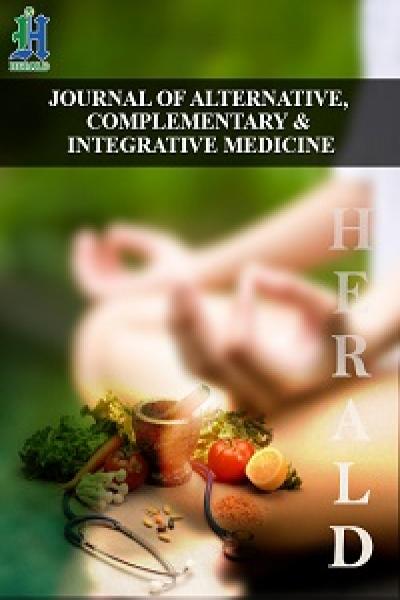
Acupuncture and Moxibustion for Cold Urticaria in a Pediatric Patient: a Case Report
*Corresponding Author(s):
Reina TaguchiDepartment Of Acupuncture And Moxibustion, Meiji University Of Integrative Medicine, Hiyoshi-cho, Nantan-Shi, Kyoto, 629-0392, Japan
Tel:+81 771721181,
Email:r_sekido@meiji-u.ac.jp
Keywords
Acupuncture; Antihistamine; Cold urticarial; Dermatology; Moxibustion; Pediatrics
Background
Cold Urticaria (CU) is a type of physical urticaria in which a cold stimulus causes local and generalized urticaria. The estimated incidence of CU is 0.05%, and it is rare in children [1]. In CU, wheals may be localized to the area exposed to cold or induced when the entire body is cold. The basic strategy for CU management is to avoid cold stimuli as much as possible; however, complete avoidance of such triggers, unlike exogenous substances, is often difficult. As such, CU treatment often focuses on oral antihistamines [2], but antihistamines alone may not completely prevent symptom onset in severe cases. In dermatology, acupuncture is reportedly beneficial for treating acne, postherpetic neuralgia, psoriasis, atopic dermatitis, and urticarial [3]. This report presents a case of a pediatric patient with CU whose symptoms appeared to be significantly improved by acupuncture and moxibustion.
Case Presentation
An 8-year-old boy presented to the author’s institute with a history of erythematous and pruritic urticarial wheals on the posterior lower leg, face and ears over the past 2 months. These symptoms always occurred within minutes of direct or indirect exposure to cold, such as local cold, playing, swimming pools and the river. The wheals resolved spontaneously within 10–60 minutes. Based on the diagnostic criteria, the patient was diagnosed with CU and prescribed antihistamines. However, the patient was reluctant to take medication and opted for acupuncture instead. At the start of the acupuncture treatment, the symptoms were triggered by exposure to air-conditioned environments, swimming pools, or the sea and walking in the rain. Swimming indoors was not possible due to the urticaria severity. His medical history and family history was unremarkable.
Acupuncture And Moxibustion Treatment
Based on Traditional Chinese Medicine, the patient was diagnosed with spleen deficiency and cold dampness were diagnosed. The treatment involved 13 sessions, initially weekly, and then spaced fortnightly and monthly. In the first treatment, the infantile non-penetrating acupuncture method (roller acupuncture, Figure 1) was applied to various body areas in addition to basic insertion and withdrawal at ST36 (Zusanli), ST40 (Fenglong), and SP6 (Sanyinjiao). Stainless steel needles (diameter, 0.16 mm; length, 30 mm) were inserted to a certain depth without any further manipulation into these points and immediately withdrawn. Acupuncture and moxibustion were administered simultaneously starting from the second treatment. Acupuncture was performed for 7 min, and needles were inserted into acupuncture points LI4 (Hegu), LV3 (Taichong), KI3 (Taixi), ST36 (Zusanli), SP6 (Sanyinjiao), BL20 (Pishu), and BL23 (Shenshu). Heat perception moxibustion was performed at CV4 (Guanyuan) and BL32 (Ciliao) and removed when 80% of the moxa had burned.
 Figure 1: The infantile non-penetrating acupuncture (roller acupuncture).
Figure 1: The infantile non-penetrating acupuncture (roller acupuncture).
Clinical Outcome
Figure 2 shows the number of days with symptoms per week; the symptoms occurred daily before treatment. After the first treatment, the patients reported development of small erythematous and pruritic urticarial lesions on exposed areas of the skin after early morning walks, playing, and exposure to air conditioning, swimming pools, and the sea. Subsequently, the number of days with symptoms per week gradually decreased (4, 2, 3, 1, 0, and 1 days in weeks 1, 2, 3, 4, 5, and 6, respectively). Seven weeks after treatment initiation, no local or generalized urticaria occurred, and no CU symptoms occurred after swimming.
 Figure 2: Number of days with symptoms per week after treatment.
Figure 2: Number of days with symptoms per week after treatment.
w=week, ws=weeks
Summary
This report suggests that acupuncture and moxibustion may play a role in treating CU-related local and generalized urticaria. Nevertheless, as this report only represents a single case, the findings should validated in prospective controlled trials with adequate sample sizes. Considering that CU can cause life-threatening reactions and CU-related anaphylactic shock cases have been reported [4], adequate coordination with medical care is necessary during acupuncture for CU.
Acknowledgement
The author thanks the patient.
Statements and Declarations
Not applicable.
Ethical Considerations
An author’s institution does not require ethical approval for reporting individual cases or case series.
Consent to Participate
Not applicable.
Consent for Publication
The patient’s guardian provided written consent for the publication of this clinical case report.v
Declaration of Conflicting Interests
The author declared no potential conflicts of interest with respect to the research, authorship, or publication of this article.
Funding Statement
The author received no financial support for the research, authorship, or publication of this article.v
Data Availability
Cite this data in author’s research
References
- Siebenhaar F, Weller K, Mlynek A, Magerl M, Altrichter S, et al. (2007) Acquired cold urticaria: clinical picture and update on diagnosis and treatment. Clin Exp Dermatol 32: 241-245.
- Sachdeva S, Gupta V, Amin SS, Tahseen M (2011) Chronic urticarial. Indian J Dermatol 56: 622-628.
- Chen CJ, Yu HS (2003) Acupuncture, electrostimulation, and reflex therapy in dermatology. Dermatol Ther 16: 87-92.
- Isk S, Arkan-Ayyldz Z, Sozmen SC, Karaman Ö, Uzuner N (2014) Idiopathic cold urticaria and anaphylaxis. Pediatr Emerg Care 30: 38-39.
Citation: Taguchi R (2025) Acupuncture and Moxibustion for Cold Urticaria in a Pediatric Patient: a Case Report. J Altern Complement Integr Med 11: 559.v
Copyright: © 2025 Reina Taguchi, et al. This is an open-access article distributed under the terms of the Creative Commons Attribution License, which permits unrestricted use, distribution, and reproduction in any medium, provided the original author and source are credited.

